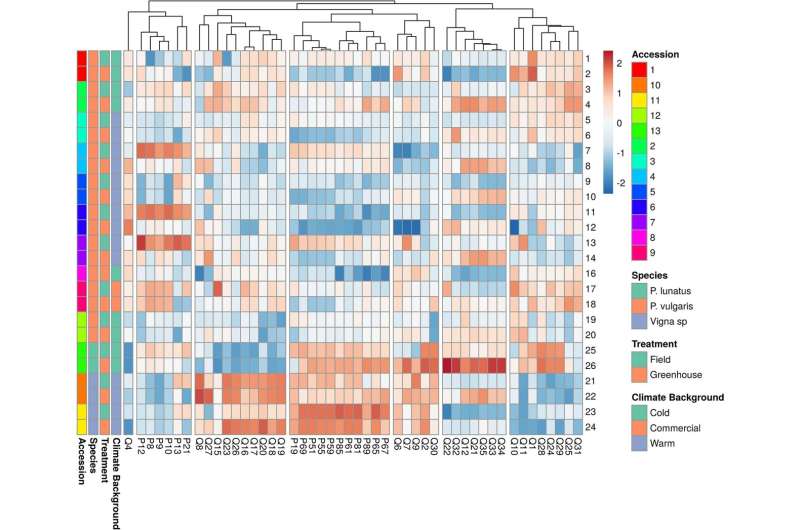Heatmap of the studied landraces based on the mean rank values for all morphological and phenological characters. Hierarchical clustering of the heatmap for all the studied characters (columns) in the 13 landraces (rows). Columns are clustered using Euclidean distance and complete linkage. Then, we stablished seven groups of characters after the results of the PCA and the parallel analysis that suggested seven factors. Credit: Scientific Reports (2022). DOI: 10.1038/s41598-022-10277-x
A team of researchers from the Universitat Politècnica de València (UPV), belonging to the Instituto Universitario de Conservación y Mejora de la Agrodiversidad Valenciana (COMAV), and the Universidad Técnica Particular de Loja (Ecuador) has evaluated the effects of climatic conditions on local and commercial varieties of beans (Phaseolus vulgaris), garrofón (P. lunatus) and green beans (Vigna unguiculata) traditionally sown under cold or hot conditions.
By subjecting these varieties to different temperatures, the researchers have evaluated the impact of the effects of climate change on vital parameters of these varieties, such as their morphology, reproduction, production, and phenology. Thus, they have detected some very sensitive types to variations in their conditions of origin. These others perform better with the increase in temperature, and others are highly resilient to any change.
The study is led by the COMAV researcher at the UPV, Mario X. Ruiz, who says, "During the research, we have identified the most fragile varieties in the face of the effects of climate change, which is why it is a priority to preserve them."
Thus, this study shows that some bean varieties perform better at higher temperatures, making them an excellent alternative to replace less productive types due to climate change. One local variety even proved to be more resistant than the commercial variety used as a control. Green beans (bachoqueta), whose origin is African, resisted relatively well to increases in temperature, as did locust beans.
The research also highlights the importance of considering the environmental and ecological background from which the varieties under study originate. In short, the results obtained have an immediate application in the conservation of agrobiodiversity by revealing which varieties are most sensitive to the effects of climate change and which should be conserved as a priority.
It also highlights the importance of promoting the resilience of food sovereignty in the face of environmental challenges, as identifying those varieties best adapted to the new conditions will allow crops to be implemented locally.
In plant breeding, the identification of traits most affected by the environment will enable crop improvement, as this research not only helps to boost adaptation to climate change but also to other disasters such as the COVID-19 pandemic, which has led to a shortage in the supply of commercial seeds in developing communities.
In this sense, Mario X. Ruiz says, "the pandemic has produced a shortage of commercial seeds in developing communities. Thanks to our research, we can find the best alternatives to maintain production locally."
The results of this study have been published in the journal Scientific Reports.
More information: Pablo G. Acosta-Quezada et al, Heterogeneous effects of climatic conditions on Andean bean landraces and cowpeas highlight alternatives for crop management and conservation, Scientific Reports (2022). DOI: 10.1038/s41598-022-10277-x
Journal information: Scientific Reports
Provided by Universitat Politècnica de València
























